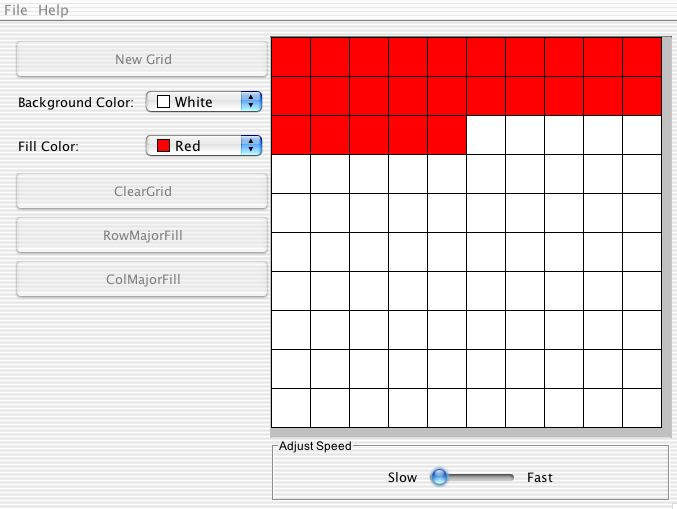In the GridPlotter assignment, students draw pictures and patterns
by placing color blocks in the cells of a grid. The purpose of the assignment
is to provide practice developing loops and nested loops for working with
a two-dimensional data structure. The assignment uses a Grid class
with rows and columns, which is a slightly cleaner data structure to work
with than Java 2D arrays. (For example, the Grid class provides
a numCols method to determine the number of columns, rather than requiring
students to ask for the length of the first row.)
We provide students with a graphical user interface and a GridPlotter class
with a rowMajorFill method provided. Students start
by implementing
clear and colMajorFill methods, closely following rowMajorFill as
an example, but then move on to a variety of other methods, such as drawing
a line down the diagonal, drawing an X, filling a triangle, and painting
the perimeter. Instructors
and interested students can come up with other possibilities, such as drawing
a spiral or butterfly. Finally, students develop three methods
of their own that combine to form a picture, such as methods that draw
the outline, roof, and windows of a house. All of their methods,
including the picture methods, should scale with the size of the grid.
The graphical user interface class that we provide to students automatically
generates buttons for any void methods without parameters
whose name fits the on...ButtonClick format (e.g., onRowMajorFillButtonClick, onXButtonClick). The
labels on the generated buttons correspond to the interior string in the
method name (e.g., "RowMajorFill," "X"). Thus,
so long as the student provides an appropriate signature for a new method,
a button corresponding to the new method will appear on the user interface
the next time they run the program.
 |
 |
| Initial program executing RowMajorFill | What a motivated student can do. |
Acknowledgements: This assignment was inspired by the Dots program by Richard Rasala of Northeastern University. The Grid class and the graphical user interface used here come from a class library that was inspired by, and derived from, the AP ®Marine Biology Simulation (MBS) case study, whose graphical user interface was written by Julie Zelenski of Stanford University.
GridPlotter class,
and to use the ensureEmpty and placeColorBlock methods provided in that
class.onRowMajorFillButtonClick method
that is provided to them. The methods that follow are carefully sequenced
to become progressively, but slowly, more difficult. We have not
seen any students unable to complete the assignment. Students with
previous background who might find it boring choose to implement additional,
more challenging methods, such as the CheckerFill and DrawGrid (a poor
name for a gingham pattern) examples above.